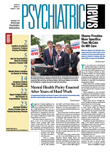Varying changes in local blood flow in two areas of the brains of auto-crash survivors predicted later adaptation to their traumatic experience, according to a study “of recovery rather than pathology” in the August 15 Biological Psychiatry.
The study scanned the brains of survivors within a few weeks of their accidents and before a diagnosis of posttraumatic stress disorder is possible. Positron emission tomography (PET) scans showed less blood flowing to the amygdala and more to the medial prefrontal cortex (mPFC) of subjects when listening to recountings of their trauma than when listening to neutral stories.
“There are specific brain correlates of normal, healthy recovery of exposed individuals, and those brain activities are located in the mPFC and the amygdala,” said lead author Elizabeth Osuch, M.D., now an associate professor of psychiatry at the University of Western Ontario in London, Ontario, in an interview. The research was conducted when Osuch was at the Center for the Study of Traumatic Stress at the Uniformed Services University of the Health Sciences in Bethesda, Md.
“In people with long-term PTSD, we find hyperactive amygdala and hypoactive mPFC—the opposite of what we're finding in these recovering people.”
The research is another step in understanding the biological basis of trauma and recovery, said Osuch. The work was funded by the National Institute of Mental Health, and the authors said it is the first study addressing neurophysiological responses to traumatic reminders observed before a diagnosis of PTSD is possible.
The researchers used PET scans to measure regional blood flow in the brains of 22 survivors of motor-vehicle collisions (MVC) and 12 nontraumatized control subjects. None had a history of head injury or major medical illness, but the accident victims had significantly higher Beck Depression Inventory scores than controls.
Osuch's group had hoped to look at both resilience and recovery and at psychopathology. However, people with more severe PTSD and more severe avoidance symptoms did not volunteer to take part in the study, she said.
After recruitment but before scanning, the survivors described their accidents in a “traumatic-reminder narrative.” One of these was then selected as a standardized trauma narrative, played for the controls. Survivors also provided a neutral narrative of a favorite activity not related to the accident.
Subjects were scanned within an average of 20 days following their accidents. Narratives were recorded and played back to the subjects during the scan. Survivors were evaluated (but not scanned) three months later as well.
The session began with one resting scan, followed by pairs of the neutral and trauma scans, in that order.
At rest, compared with healthy controls, the accident victims showed higher resting blood flow in a right medial prefrontal cortex (mPFC) area in the anterior cingulate sulcal area and lower flow in the right amygdala. During subsequent scans, accident victims listening to trauma narratives showed decreased flow in the right amygdala and left amygdala/perirhinal cortex, compared with when they heard the neutral narratives.
Subjects were evaluated using the Impact of Events Scale-Revised (IES-R). On average, the accident survivors' IES-R score was above the threshold for clinical significance. However, at the three-month follow-up evaluation, only four of the 22 subjects had elevated IES-R scores. Only one met criteria for PTSD.
“Thus, most of the MVC subjects were 'resilient'—that is, they experienced a traumatic event, showed a transient stress response, and went on to recovery,” wrote the authors. “[The results] suggest an adaptive process in recovering individuals that involves deactivation of the perirhinal cortex, perhaps as a means of terminating or preventing fear-potentiating associations.”
The clinical value of this information is still unclear, but the research may contribute to broader discussions of psychological injury and health, said Osuch.
“We live in a world where mental illness is very much stigmatized,” she said. “We stigmatize pathology but don't understand the biological basis of the pathology. Neither do we understand or appreciate the biological aspects of resilience or health. This is one more thing to add to that understanding.”
An abstract of “Neurophysiological Responses to Traumatic Reminders in the Acute Aftermath of Serious Motor Vehicle Collisions Using [15O]-H2O Positron Emission Tomography” can be accessed at<www.journals.elsevierhealth.com/periodicals/bps/article/PIIS0006322308003028/abstract>.▪
